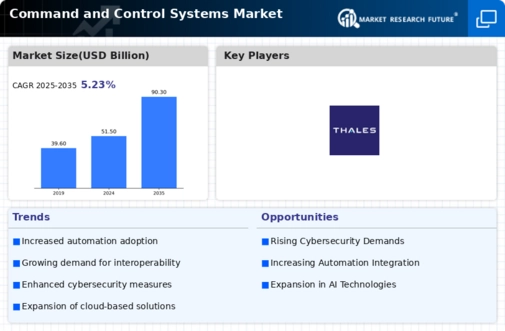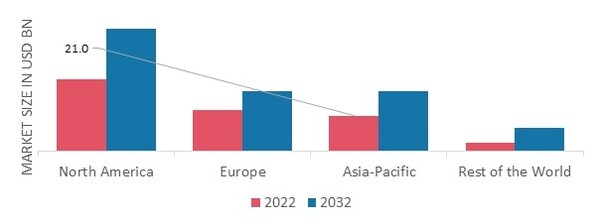Market Trends
Introduction
In the year 2024, the Command and Control Systems market is undergoing a major transformation. This transformation is mainly due to the confluence of macroeconomic factors. Artificial intelligence, machine learning and cyber security are reshaping the way operations are conducted and decision-making is done. In parallel, the regulatory environment is becoming more and more demanding, requiring organizations to adopt more robust and compliant systems to meet national and international standards. Lastly, changes in the buying behaviour of consumers, in particular their demand for more integrated and simpler solutions, are influencing the product development and the service delivery. These trends are strategically important for the industry, as they not only influence the positioning and the competitive strategy, but also the investment and innovation strategies in an increasingly complex security environment.
Top Trends
-
Integration of AI and Machine Learning
Artificial intelligence and machine learning are transforming the way command and control systems make decisions. For example, the United States Department of Defense is investing heavily in artificial intelligence in order to increase situational awareness. According to reports, the speed of responses could be reduced by up to 30 per cent, with significant effects on operational efficiency. This trend is expected to lead to more self-learning systems, which will make it possible to respond faster and more accurately in critical situations. -
Cybersecurity Enhancements
Keeping the systems that command and control the military forces secure has become a top priority in the field of cyber security. Governments have set aside significant budgets to counter cyber threats, and by 2023 it is expected that spending on cyber security will have risen by a quarter. Consequently, there will be an increase in the number of cyber security personnel. -
Cloud-Based Command and Control Solutions
The need for scalability and flexibility has pushed the move to cloud-based control and command systems. The big defense contractors are developing cloud platforms that allow for real-time data sharing and collaboration. The trend is expected to improve interoperability between allies, facilitate joint operations, and improve the chances of success in complex environments. -
Increased Focus on Interoperability
In the field of command and control, the interoperability of the different military branches and allied nations is becoming a matter of growing importance. NATO’s Interoperability Framework aims to standardize communication protocols. Interoperability increases the effectiveness of joint operations. Studies have shown that the success rate is increased by up to 40 per cent by the use of integrated systems. -
Adoption of 5G Technology
A change in the way of transmitting data is in the air, a change that is preparing to take place with the introduction of 5G technology. For military applications, the possibilities of 5G are already being explored for real-time data analysis and enhanced communication. This advance is expected to enable more complex operations and to increase the efficiency of remote command centres. -
Emphasis on Human-Machine Collaboration
The future of command and control systems lies in the human-machine partnership, where the operators are to work with the advanced systems. The training of personnel for this task is under way, and studies have shown that the effective collaboration will increase the speed of decision-making by up to 20 per cent. This will change the roles within the command structure and make the human element more important. -
Use of Advanced Simulation Technologies
In the field of command and control, the use of modern simulation methods is becoming more and more common. Companies are investing in virtual and augmented reality to create a realistic training environment. This has been shown to improve the quality of the training by up to 50%, resulting in better prepared personnel and more effective mission performance. -
Development of Modular Systems
Modular command and control systems allow for greater flexibility and adaptation to the needs of specific missions. The companies design systems that can be easily modified or extended, which increases the system’s life and reduces its life-cycle costs. Such flexibility is crucial for military organizations that have to cope with a constantly changing environment. -
Increased Investment in Research and Development
An increase in research and development is being observed in command and control systems, prompted by the need for innovation and technological progress. There is an increase of 15% in R & D in the defense budgets in 2023. This tendency is expected to produce advances that will increase the capabilities and the effectiveness of operations. -
Focus on Sustainability and Energy Efficiency
It is a question of a green conscience, which is a major consideration in the development of command and control systems, where energy saving is a major concern. Governments are setting targets for reducing carbon emissions, which is bringing about innovation in energy management. The aim is not only to reduce the environmental impact, but also to reduce the operating costs and ensure that the systems are more sustainable.
Conclusion: Navigating Command and Control Dynamics
The Command and Control System Market in 2024 is characterized by a high degree of competition and significant fragmentation. Several established and new players will compete for dominance. The trend is towards localized solutions, with vendors adapting to local geopolitical and operational conditions. The established players will rely on their reputation and experience, while the new players will focus on developing new features such as artificial intelligence, automation and sustainability. As the market evolves, the ability to offer flexible and scalable solutions will be crucial for leadership. Vendors must therefore focus on these features in order to meet current demands and to anticipate future challenges and remain relevant in a rapidly changing environment.





Leave a Comment